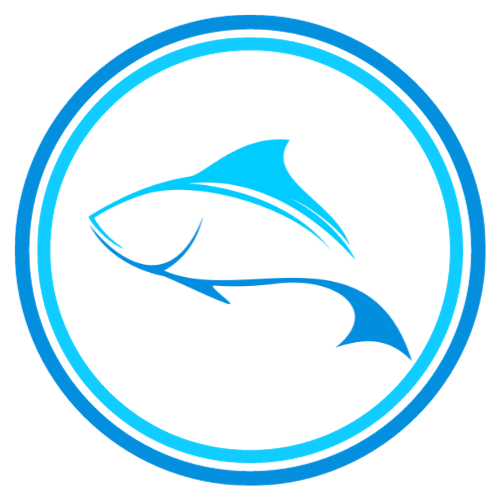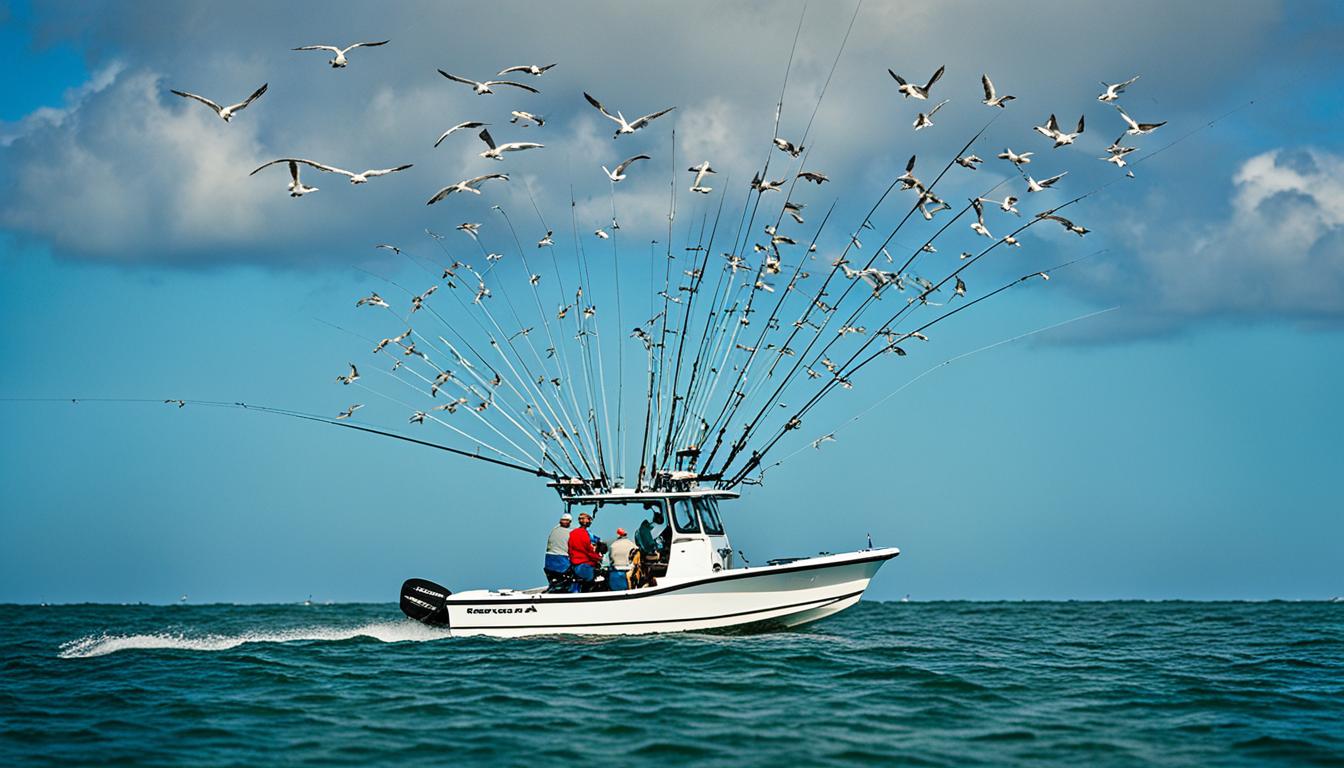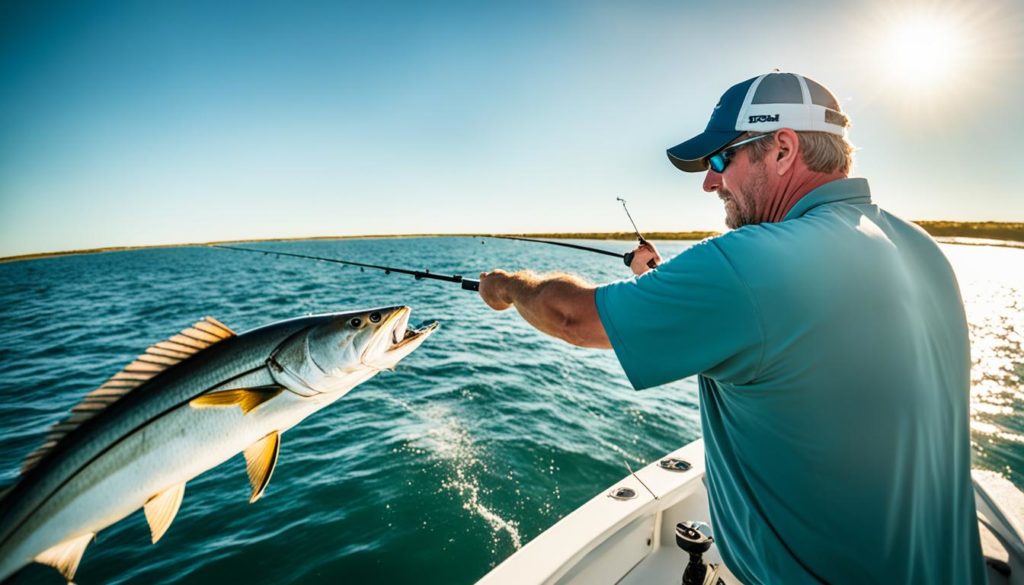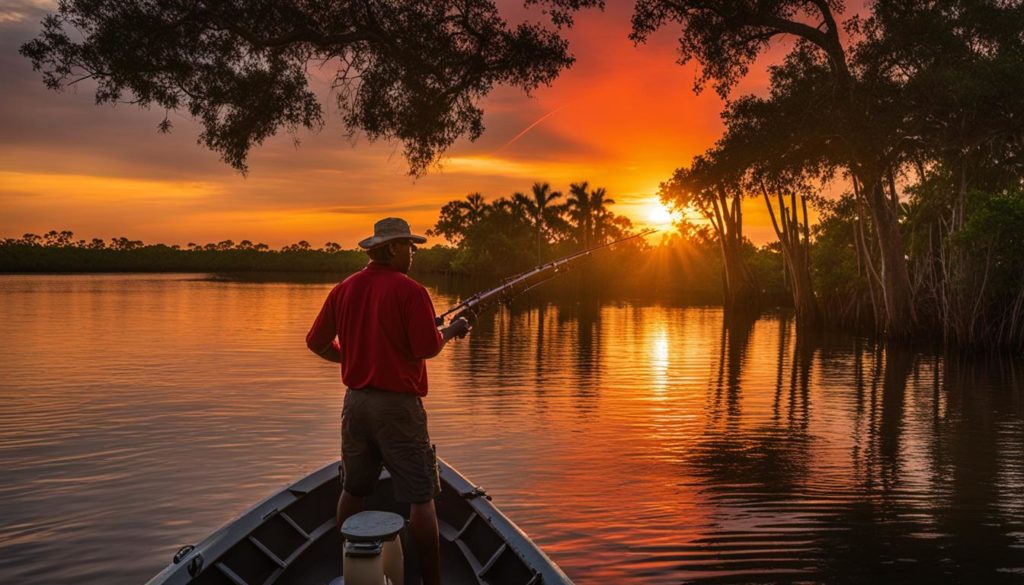Cobia are a popular fish to catch in Florida due to their abundance and delicious taste. In this ultimate guide, we will cover everything you need to know about catching cobia in Florida. We will discuss the best fishing techniques, the top spots to find cobia, the gear you need, and the regulations you should be aware of. Whether you’re a novice or an experienced angler, this guide will help you have a successful cobia fishing trip in Florida.
Key Takeaways:
- Learn the best fishing techniques for catching cobia in Florida.
- Discover the prime fishing spots where cobia are abundant.
- Understand the essential gear needed for cobia fishing.
- Stay updated on the fishing regulations to ensure compliance.
- Consider booking a fishing charter in Crystal River for a guided cobia fishing experience.
Now, let’s dive into the details of understanding cobia behavior and habitat.
Understanding Cobia Behavior and Habitat
Cobia, also known as Ling and Lemonfish, exhibit distinct behavior and have specific habitat preferences that can help anglers effectively target this prized species. Understanding the behavior and habitat of cobia is essential for a successful fishing trip.
Cobia Behavior
Cobia are bottom feeders that frequently hide and feed around various underwater structures, including shipwrecks, reefs, buoys, and pilings. They rely on these structures to provide both shelter and a steady supply of food.
“Cobia are bottom feeders that often hide and feed around underwater structures such as shipwrecks, reefs, buoys, and pilings.”
Their behavior also involves following larger marine creatures, such as manta rays and other types of rays, as they search for potential prey items. These opportunistic feeders have a voracious appetite and are known for their willingness to take a wide range of baits and lures.
Cobia Habitat
Cobia can be found in a wide range of water depths, from shallow flats to deep offshore structures. Their habitat preferences are closely tied to the availability of food sources and suitable structures to hide and feed.
“Cobia can be found in a wide range of water depths, from shallow flats to deep offshore structures.”
They are commonly found in coastal areas with structures that provide cover, such as wrecks and reefs. Cobia are often attracted to areas with abundant baitfish populations, as these serve as a food source and draw them in. When targeting cobia, it’s crucial to identify these specific areas within their habitat.
Cobia Movement Patterns
Cobia are migratory fish, and their movement patterns are primarily influenced by water temperatures. They prefer water temperatures between 68 and 72 degrees Fahrenheit.
“Cobia are migratory fish, with their movement patterns influenced by water temperatures.”
During the spring and early summer, cobia congregate in large numbers for spawning. This is when they are most abundant and often spotted in groups. As the seasons change and water temperatures fluctuate, they move to different areas to seek out optimal conditions for feeding and reproduction. Understanding these movement patterns can significantly improve your chances of locating and catching cobia.
| Key Points | Cobia Behavior and Habitat |
|---|---|
| Behavior | Bottom feeders |
| Hide and feed around underwater structures | |
| Follow larger marine creatures | |
| Habitat | Found in various water depths |
| Prefer areas with structures as cover | |
| Attracted to areas with abundant baitfish populations | |
| Movement Patterns | Migratory fish |
| Prefer water temperatures between 68 and 72 degrees Fahrenheit | |
| Concentrate in groups for spawning |
Prime Fishing Spots for Cobia in Florida
In Florida, there are several prime fishing spots where you’re likely to find cobia. These include coastal buoys, shipwrecks, reefs, and areas near inlets where cobia follow manta rays and other types of rays. Crystal River is particularly known for its abundance of suitable habitats and food sources for cobia. By exploring these prime fishing spots, you’ll increase your chances of landing a cobia.
Crystal River, with its unique ecosystem, is a top destination for cobia fishing enthusiasts. Situated on Florida’s Gulf Coast, this picturesque area offers a diverse range of habitats that attract cobia. The crystal-clear waters of Crystal River are home to an extensive network of submerged structures, including reefs, shipwrecks, and buoys, making it an ideal hunting ground for these powerful fish. Additionally, the numerous inlets and channels provide opportunities for cobia to follow their preferred prey, such as manta rays and other types of rays, which migrate along the coast.
By positioning yourself near coastal buoys, shipwrecks, and reefs, you can intercept cobia as they navigate these structures in search of food and shelter. These locations offer excellent opportunities for sight fishing, allowing you to spot cobia swimming near the surface. When choosing fishing spots, keep in mind the depth of the water, as cobia can be found in both shallow flats and deeper offshore areas, depending on the season and water temperature.
In Crystal River, you’ll find a variety of guided fishing charters that specialize in cobia fishing. These experienced local captains possess in-depth knowledge of the area’s prime fishing spots and can provide invaluable guidance to ensure a successful fishing trip. Whether you’re a seasoned angler or a novice, exploring the cobia fishing spots in Crystal River will undoubtedly enhance your chances of hooking into these prized fish.
Remember, always adhere to fishing regulations and practice responsible angling to preserve the cobia population and their habitat. With the right knowledge, gear, and a bit of luck, you’ll have an unforgettable cobia fishing experience in Florida.
Essential Gear for Cobia Fishing
To catch cobia successfully, you’ll need the right gear. Here are the essential items you should have for a successful cobia fishing trip:
- Cobia Fishing Rods: A medium-heavy to heavy action rod around 7 to 8 feet long is ideal for cobia fishing. Look for rods that offer both strength and flexibility to handle the power of a cobia.
- Cobia Fishing Reels: Pair your rod with a high-quality spinning or conventional reel. For cobia fishing, choose a reel with a solid drag system and enough line capacity to handle 30-50 lb test monofilament or braided line.
- Cobia Fishing Tackle: When it comes to tackling cobia, both live baits and artificial lures can be effective. Live baits such as crabs, eels, or pinfish are highly enticing to cobia. Additionally, artificial lures like bucktail jigs, large swimbaits, and surface plugs can also entice cobia to strike.
- Cobia Fishing Net or Gaff: It’s important to have a large landing net or gaff to safely land and handle the cobia once you’ve hooked it. These tools will help you bring the cobia onboard without losing it or injuring yourself.
By having the right combination of cobia fishing gear, you’ll be well-prepared to tackle these powerful and elusive fish.
Best Techniques for Catching Cobia
When it comes to catching cobia, employing the right techniques can significantly increase your chances of success. Whether you prefer using live bait or artificial lures, understanding the behaviors and movement patterns of cobia is crucial to optimize your fishing experience. Here are some expert tips to help you master the art of cobia fishing:
1. Live Bait Techniques
When using live bait for cobia fishing, it’s essential to cast your bait near structures or areas where cobia activity is spotted. Allow the bait to drift naturally with the current, mimicking the movements of their natural prey. Keep your line tight and be ready for a strike, as cobia are known for their sudden and aggressive attacks.
2. Artificial Lure Techniques
If you prefer artificial lures, casting beyond the target area is recommended. Retrieve your lure with a steady, moderate-speed retrieve or use a jigging motion to entice cobia. Experiment with different lures such as bucktail jigs, large swimbaits, and surface plugs to see what works best in your fishing location. Remember, cobia are drawn to movement, so make sure to create enticing actions with your lure.
3. Observe Cobia Behavior
Take the time to observe the behavior and movement patterns of cobia in your fishing area. Look for signs of their presence, such as swirling baitfish or birds diving into the water. Cobia often follow these feeding frenzies, so casting into these areas can yield great results. Additionally, pay attention to their surface movements and any water disturbances – they may indicate the presence of cobia.
4. Maintain Constant Pressure
Once you’ve hooked a cobia, it’s crucial to maintain constant pressure on the fish while reeling it in. Cobia are renowned for their powerful runs and headshakes, so keeping a tight line and applying steady pressure will help you control the fight. Be patient and avoid making sudden movements or jerking the rod, as this can cause the cobia to escape.
By employing these techniques and adapting to the specific conditions of your fishing location, you’ll increase your chances of landing that prized cobia. Remember, cobia fishing requires patience, persistence, and a deep understanding of their behavior. Happy fishing!
Landing and Handling Cobia
Landing a cobia can be a thrilling challenge due to their impressive size and strength. To successfully land a cobia, it is crucial to maintain constant pressure on the fish while reeling it in. As the cobia nears the boat, it is recommended to use a large landing net or gaff to safely bring it on board.
Handling cobia requires caution and care as they can be vigorous and thrash out of your hands. It is essential to have a firm grip on the fish to prevent it from slipping away. Utilizing tools such as pliers to remove the hook is advisable to avoid any potential harm to yourself or the cobia.
When landing and handling cobia, always prioritize the welfare of both the fish and yourself. By following proper techniques and utilizing appropriate tools, you can ensure a safe and successful cobia fishing experience.
Fishing Regulations for Cobia in Florida
When fishing for cobia in Florida, it’s crucial to understand and abide by the fishing regulations set forth by the Florida Fish and Wildlife Conservation Commission (FWC). These regulations help protect the cobia population and ensure sustainable fishing practices. Familiarize yourself with the following regulations to have a responsible and enjoyable fishing experience:
Season and Restrictions
The cobia fishing season in Florida is open year-round, providing anglers ample opportunities to target this prized species. Unlike some other fish, cobia fishing does not have specific seasonal restrictions. However, it’s essential to check for any temporary closures or changes to the regulations before heading out on your fishing trip.
Size Limits
Florida has minimum size limits in place to protect juvenile cobia and allow them to reach maturity for reproduction. The current size limit for cobia in both Atlantic and Gulf state waters is 36 inches. Any cobia caught that measures below this minimum size must be released immediately and unharmed.
Bag Limits
To preserve the cobia population and ensure sustainable fishing, bag limits are enforced in Florida. As of the latest regulations, anglers are allowed to keep one cobia per day or two cobia per vessel. It is important to adhere to these bag limits to avoid overfishing and help maintain healthy cobia populations for future generations.
FWC Website
The regulations mentioned here are the most up-to-date at the time of writing. However, it’s always a good idea to check the official FWC website for any changes or updates to cobia fishing regulations. The FWC website provides accurate and detailed information regarding fishing regulations, license requirements, and other important guidelines. Stay informed and be a responsible angler by regularly visiting the FWC website.
By following the fishing regulations for cobia in Florida, including understanding the open season, size limits, and bag limits, you can enjoy a thrilling and sustainable fishing experience. Remember, responsible fishing practices ensure the long-term sustainability of cobia populations, allowing future generations to also enjoy this fantastic sport. Happy cobia fishing!
Fishing for Cobia in Crystal River
Crystal River is a prime location for cobia fishing, offering a variety of underwater structures and habitats that attract these prized fish. The crystal-clear waters of Crystal River provide excellent visibility, making it easier to spot cobia and target them with precision.
One of the best ways to experience cobia fishing in Crystal River is by booking a fishing charter. There are numerous fishing charters available that specialize in cobia fishing and have extensive knowledge of the area. These experienced guides know the best spots for cobia fishing in Crystal River, increasing your chances of landing a prized catch.
Fishing charters in Crystal River provide all the necessary equipment and expertise to make your cobia fishing trip a success. They can provide you with top-of-the-line gear, including rods, reels, and tackle, ensuring that you have the right tools to reel in your trophy cobia. Additionally, the knowledgeable guides can offer valuable insights and tips on cobia behavior and the most effective fishing techniques.
Embarking on a fishing charter in Crystal River not only enhances your chances of catching cobia but also provides a memorable experience. While you fish, you can soak in the picturesque surroundings of Crystal River, with its scenic views and abundant wildlife. It’s an opportunity to connect with nature and enjoy a day of thrilling angling adventures.
Whether you’re a seasoned angler or a novice, fishing for cobia in Crystal River is an experience you won’t want to miss. The combination of the stunning natural beauty of Crystal River and the excitement of cobia fishing creates a unique and unforgettable experience for fishing enthusiasts.
So why wait? Book a fishing charter in Crystal River, and let the experienced guides lead you to the best spots for cobia fishing. Get ready for an adventure-filled day of reeling in big cobia and creating lasting memories.
Conclusion
Embarking on a cobia fishing adventure in Florida promises an exhilarating and fulfilling experience. By employing the right techniques, employing the proper gear, and familiarizing yourself with the prime fishing spots, you can significantly enhance your chances of reeling in a prized cobia. It is essential to adhere to the fishing regulations and handle these powerful fish with care to preserve their well-being. Whether you are a novice angler seeking new challenges or a seasoned pro, Florida offers an abundance of opportunities for successful cobia fishing. Consider booking a fishing charter in Crystal River for a guided expedition or venture out to explore the fishing spots independently. As you immerse yourself in the thrill and beauty of cobia fishing in the Sunshine State, cherish the memories created along the way.
FAQ
How do I catch cobia in Florida?
To catch cobia in Florida, you’ll need the right gear, such as a medium-heavy to heavy action rod, a high-quality reel, and live baits or artificial lures. You’ll also need to locate prime fishing spots where cobia are known to gather, such as coastal buoys, shipwrecks, reefs, and areas near inlets.
What are the best techniques for catching cobia?
When using live bait, cast near structures or areas where cobia activity is spotted and let the bait drift naturally. For artificial lures, cast beyond the target area and retrieve with a steady, moderate-speed retrieve or a jigging motion. Pay attention to cobia behavior and movement patterns to anticipate where to cast your bait or lure.
What gear do I need for cobia fishing?
For cobia fishing, you’ll need a medium-heavy to heavy action rod around 7 to 8 feet long, paired with a high-quality spinning or conventional reel. Make sure to have a large landing net or gaff to safely land and handle the cobia.
Where are the prime fishing spots for cobia in Florida?
Prime fishing spots for cobia in Florida include coastal buoys, shipwrecks, reefs, and areas near inlets where cobia follow manta rays and other types of rays. Crystal River is particularly known for its abundance of suitable habitats and food sources for cobia.
What are the fishing regulations for cobia in Florida?
The season for cobia is open year-round in Florida, with no significant restrictions. However, there are minimum size limits of 36 inches for both Atlantic and Gulf state waters, and you can keep one fish per day or two fish per vessel. It’s important to stay updated on any changes to the regulations by checking the Florida Fish and Wildlife Conservation Commission (FWC) website.
How do I land and handle a cobia?
Landing a cobia can be challenging due to their size and strength. Keep constant pressure on the fish while reeling it in and use a large landing net or gaff to bring it on board. Be cautious when handling cobia as they can be strong and may thrash out of your hands. Use a firm grip and proper tools like pliers to remove the hook.
Where can I go cobia fishing in Crystal River?
Crystal River is a prime location for cobia fishing due to its diverse underwater structures and habitats. There are many fishing charters available in Crystal River that can guide you to the best spots for cobia fishing. These experienced local guides will improve your chances of catching cobia and provide you with a memorable fishing experience in the picturesque waters of Crystal River.



